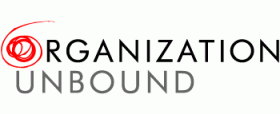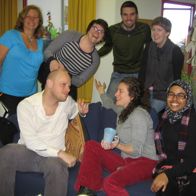-
I’ve found myself thinking a lot lately about the power of inscaping in the context of my experience as a staff member at COCo. Over the past several years, we have shifted towards a more collaborative organizational structure. And although the conscious shifts that we’ve made have centred around things like roles, job descriptions, and lines of accountability, I have also felt a subtler but equally powerful shift in our ability to opening and honestly express how we are feeling in our work and with each other.
During the early days of re-structuring, I spent a lot of time doling out prescriptions for how I thought the organization should function, based on past experience and what I had read about successful collaborative structures. For example, I would say, “For COCo to be healthy, we really need to have more time to meet as a whole staff team”. Eventually, I felt myself and others grow tired of my prescriptions. My sense was that people were feeling like I was telling them how they should work, which was completely counter to my intention. I just felt passionate about creating a work environment that I myself would thrive in.
Things really began to shift for me, however, when I stopped trying so hard to frame my feelings from some falsely universal organizational perspective and began to speak from my own personal perspective: “For me to feel good working here, I really need more time to talk and think with you guys.” I felt a great weight begin to lift off of me. I suddenly felt that people were listening to me rather than reacting to me and that I was listening rather than reacting to them.
However, this shift didn’t come easily. I had to really re-train my brain. I made an effort to catch myself and even asked others to help me become more aware. Over time, it got easier and easier. I was also helped by the fact that other people were modeling this sort of inscaping really well.
It may seem like a subtle shift, but it made all the difference. Once I stopped prescribing, I found that many of the very things I was so desperate to see began to happen quite naturally. My guess is that other people (even those with seemingly “competing” prescriptions) found the same thing. Perhaps we discovered that our perspectives weren’t actually contradictory but simply expressed aspects of a greater whole.
In his book Learning in Relationship, Ronald Short describes this kind of shift as moving from ‘outside-in’ language to ‘inside-out’ language. He says that ‘outside-in’ or ‘objective’ language places everything that happens ‘out there’ outside of you and totally independent of you. This makes you a passive spectator, even a non-entity, who is simply acted upon by the external environment. He gives the following examples:
“It is a beautiful day.” vs. “I feel energized and excited.”
“You’re a great artist.” vs. “I love this painting.”
“He’s incompetent.” vs. “I’m frustrated and need help.”
He goes on to note that outside language is arguable. We can fight until we are blue about whether or not it is a beautiful day, or this painter is a great artist, or this person is incompetent. Inside language is inarguable. I may be having a miserable day, and I may hate this weather, but I can’t tell you that you don’t feel energized and excited. Nor can I tell you that you don’t love this painting.
Like my own experiences, Short’s examples are seemingly mundane, but I think they represent a really powerful shift in how we relate to each other and the world. Inscaping seems to open up wholly different possibilities for organizing.
At COCo, I’ve been appreciating the wisdom that these inscaping moments bring to our work and our ability to create a structure that truly responds to our needs. Not only do we do it more often, but we do it more openly and with more candour. And I’ve found myself no longer dreading but welcoming experiences that seem to contradict my own. I actually look forward to hearing about them and can increasingly see and appreciate how much richer they make my own thinking.
Inscaping at COCo





3 Responses and Counting...
The element I love that’s tied to this and the creativity that comes from personalizing needs are our daily ‘lunch parties’ – my recollection of lunch when I started working at COCo was hurried sandwiches at my desk. I think lunch parties came out of making ourselves vulnerable enough to challenge workaholic gogoness… They’ve since become an important part of our culture and I’ve seen us use them successfully to both connect with each other while occasionally debriefing more challenging aspects of our work.
I really like this sharing, Tana. You describe really eloquently one of the things that I enjoy about working in a collaborative environment.
As a past Board member at COCo (I believe that I walked in literally the day that the Director had announced his departure more publicly), I remember finding inscaping more challenging in situations where board & staff were working together on something.
To be true to this topic, I will share some of my own lived experiences. At Head & Hands, we start our Board and Staff meetings with ‘check-ins’ that help to ground us in the present, and encourage people to share feelings in general. Sometimes this is as simple as “I saw a movie last night and it was awesome” to “I’m really tired today.” We also create time after our ‘program highlights’ section where people can ask each other questions, give responses or ask for support.
I start my supervision sessions with staff with “how are you feeling lately at work?” which helps to guide my tone and approach with staff throughout our conversation.
I’m wondering how I can learn from your piece in terms of working with our Board volunteers. We also start Board meetings with check-ins, and re-cap our collective norms i.e. ‘Use I statements,’ which speaks to the inscaping that you describe above. At the same time, I don’t always find it easy to promote a space where people can comfortably say “I don’t understand this” or “I don’t agree” or “I can support this, but not really this part of it.” I think that the role of modeling is really important. As a Director in a collaborative hybrid model, I know that I can help to set a tone where inscaping is welcomed and encouraged.
I also like Alex’s suggestion about lunch parties! I can’t wait for the weather to get warmer in Montreal so we can gather at the table on our rooftop!
Thanks for introducing me to this blog (-;
Marlo
So happy to see you here, Marlo, and thank you for sharing examples from your own experience at Head and Hands.
I totally agree with you about the challenge of nurturing these kinds of really meaningful exchanges between board and staff. On one hand, I feel like a lot of the difficulties in this area are inherent in an organizational model where a group of people relatively distanced from the daily life of an organization (a board) is held legally responsible for its ultimate health. This responsibility often weighs heavily on board members, both from a feeling of commitment and from a fear of the worse case scenario. I personally think that we need to re-examine the legal model of nonprofit organizations.
On the other hand, I’ve had a board experience within this model that was extremely positive in terms of board/staff relations…which makes me think that although the current legal model strongly influences the way in which board and staff interact, creating as many opportunities for board and staff to work and think together can do wonders in creating a sustained culture of trust and understanding. I have faith that if we strongly hold on to the intention to create even the smallest moments of inscaping between board and staff, things will begin to shift. And I think the most accessible and catalytic way to do this is to begin living the change you want to see in the group yourself. As I often hear Rennie say, it is with fierce intentions and humble means that we can begin to catalyze deep and sustained change.
I think you’d enjoy reading Rennie’s earlier post on this topic The Experiential Turn if you haven’t already. He talks about the importance of being really flexible in terms of the forms that inscaping might take. I found the “check-in” example he gives quite helpful in thinking about my experience at COCo.